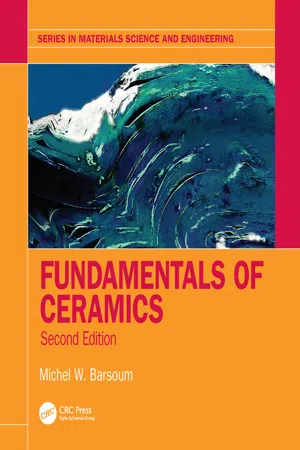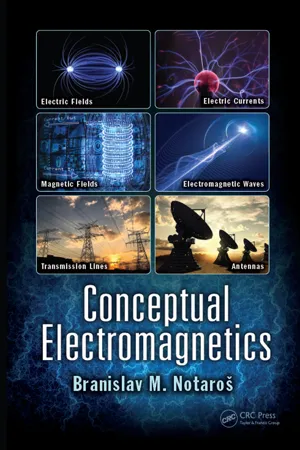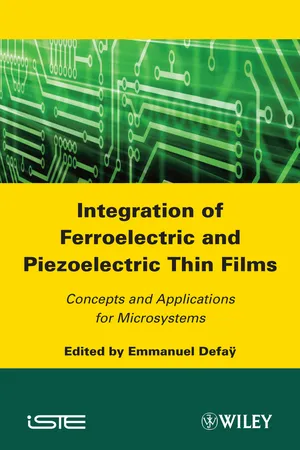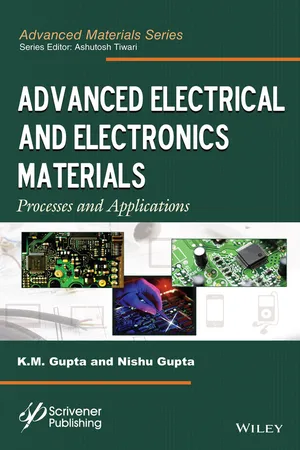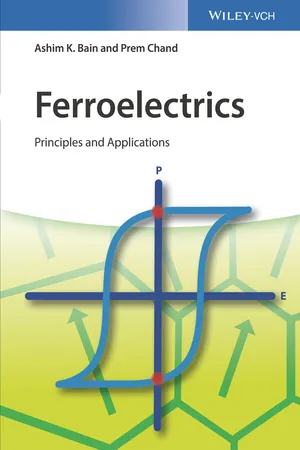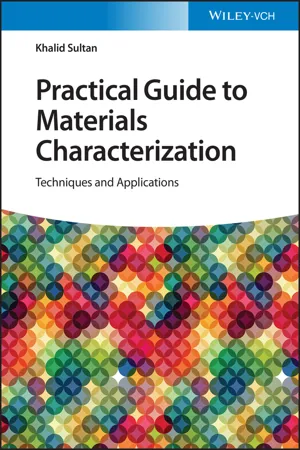Physics
Linear Dielectric
A linear dielectric is a material that exhibits a linear relationship between the electric field applied to it and the resulting polarization. When an electric field is applied, the atoms or molecules within the dielectric material become polarized, leading to the material's ability to store electrical energy. This property is characterized by the material's permittivity, which quantifies its ability to resist an electric field.
Written by Perlego with AI-assistance
Related key terms
Related key terms
1 of 4
Related key terms
1 of 3
10 Key excerpts on "Linear Dielectric"
- eBook - ePub
- Michel Barsoum(Author)
- 2019(Publication Date)
- CRC Press(Publisher)
14Linear Dielectric Properties
It serves to bring out the actual mechanical connexions between the known electro-magnetic phenomena; so I venture to say that any one who understands the provisional and temporary character of this hypothesis will find himself rather helped than hindered by it in his search after the true interpretation of the phenomena.James Maxwell, Phil. Mag., 21 :281 (1861).14.1 Introduction
Dielectric materials do not conduct electricity and as such are of critical importance as capacitive elements in electronic applications and as insulators. It could be argued, with some justification, that without the discovery of new compositions with very high charge-storing capabilities, i.e., relative dielectric constants k ′ > 10,000, the impressive miniaturization of semiconductor-based devices and circuits would not have been possible. In addition, the traditional use of ceramics as insulators in high-power applications is still a substantial economic activity.In contrast to electrical conductivity, which involves long-range motion of charge carriers, the dielectric response results from the short-range motion of these carriers under the influence of an externally applied electric field, E. Inasmuch as all solids are comprised of positive and negative entities, the application of E to any solid will result in a separation of its charges. This separation of charge is called polarization , defined as the finite displacement of bound charges of a dielectric in response to an applied electric field. If permanent electric dipoles exist in the dielectric and are mobile, they will orient parallel to the direction of E.The dielectric properties can vary widely between solids and are a function of temperature, frequency of applied field, humidity, crystal structure, and other external factors. Furthermore, the response can be either linear or nonlinear - eBook - ePub
- Michael M. Mansfield, Colm O'Sullivan(Authors)
- 2020(Publication Date)
- Wiley(Publisher)
Experimentally, for most dielectric materials, it is found that | E pol | is directly proportional to | E | over a reasonably wide range of field strength values, that is The constant of proportionality χ e is called the electric susceptibility and is characteristic of the material involved. Note that, since P = − ε 0 E pol, the electric polarization is Thus, using Equation (17.3), the electric field strength at a point within a dielectric material is given by Hence and we can now interpret the permittivity of the medium to be Values of permittivity are often given in terms of relative permittivity, the value of the permittivity relative to that of vacuum, that is For most dielectric materials in typical electric fields, therefore, a plot of D versus E (or P versus E) yields a straight line (Figure 17.7). Such substances are described as linear materials. Figure 17.7 Plot of polarization versus electric field strength for a linear material. The slope of the straight line is ε 0 χ e. In the discussion above it has been assumed that substances under discussion were linear, isotropic and homogeneous (that is, l.i.h. materials). Examples of materials with non‐linear electrical properties will be discussed in Section 17.5. 17.4 Boundaries between dielectric media In the discussion presented in earlier sections of this chapter it has been assumed that all sources of electric field have either been in vacuum or embedded in an effectively infinite non‐conducting medium. In the case of situations involving two or more media of different electric permittivities, however, care must be exercised in applying the results obtained. Issues do not generally arise when the electric field is applied at right angles to the surfaces of the specimen - eBook - ePub
- Branislav M. Notaroš(Author)
- 2017(Publication Date)
- CRC Press(Publisher)
ELECTROSTATIC FIELD IN DIELECTRICS IntroductionDielectrics or insulators are nonconducting materials, having very little free charges inside them (theoretically, perfect dielectrics have no free charges). However, another type of charge, called bound or polarization charges, exist in a polarized dielectric, as atoms and molecules in the dielectric behave like microscopic electric dipoles. In electrostatic systems containing both conductors and dielectrics, the equivalent electric-field sources are both free and bound charges, considered to reside in free space. By introducing the concept of dielectric permittivity, we are left, in turn, to deal with free charges in the system only, while the contribution of bound charges to the field is properly added through the permittivity. In continuation, we analyze capacitors and transmission lines, composed of both conductors and dielectrics, to evaluate and discuss their capacitance, energy, and breakdown characteristics, as a culmination of our study of the theory and applications of the electrostatic field.2.1 Polarization of DielectricsEach atom or molecule in a dielectric is electrically neutral. For most dielectrics, centers of “gravity” of the positive and negative charges in an atom or molecule coincide – in the absence of the external electric field. When a dielectric is placed in an external field, of intensity E, however, the positive and negative charges shift in opposite directions against their mutual attraction, and produce a small electric dipole. The moment of this equivalent dipole is given by p = Qd, where Q is the positive charge of the atom or molecule (−Q is the negative charge), and d is the vector displacement of Q with respect to −Q. The charges are displaced from their equilibrium positions by forces [Eq. (1.3) ] Fe1 = QE and Fe2 = −QE, respectively. The displacement d is very small, on the order of the dimensions of atoms and molecules. The charges Q and −Q are bound in place by atomic and molecular forces and can only shift positions slightly in response to the external field. So, the two charges in an equivalent small dipole cannot separate one from the other and migrate across the material in opposite directions run by the electric field. Hence, these charges are called bound charges (in contrast to free charges). Some dielectrics, such as water, have molecules with a permanent displacement between the centers of the positive and negative charge, so that they act as small electric dipoles even with no applied electric field. According to Figure 2.1 , the torques (moments) of forces Fe1 and Fe2 with respect to the center of the dipole (point O) are T1 = r1 × Fe1 and T2 = r2 × Fe2 , with r1 and r2 denoting the position vectors of Q and −Q with respect to the dipole center. We notice that r1 − r2 = d - eBook - ePub
- Sivaji Chakravorti(Author)
- 2017(Publication Date)
- CRC Press(Publisher)
518.02i ^+ 388.54j ^− 259.05k ^)pC/m 25.6 Classification of Dielectrics
Equations 5.44 through 5.48 are not applicable to dielectric materials in general. These equations are valid for a sub-class of dielectric materials known as LIH materials. LIH dielectrics exhibit the following properties:- Linearity : A dielectric is said to be linear ifD →varies linearly withE →. For such materials, permittivity is constant and independent of applied electric field. For non-Linear Dielectrics,D →andE →have non-linear relationship.
- Isotropy : A dielectric is said to be isotropic ifD →andE →are in the same direction. Isotropic dielectrics have same permittivity in all directions. For anisotropic materials,, andD →,E →P →are not parallel and hence permittivity varies with direction. Crystalline dielectrics are mostly anisotropic.
- Homogeneity : Dielectric materials for which properties are same at all points within the volume of the material are called homogeneous . For inhomogeneous dielectrics, properties such as permittivity vary with space coordinates. A typical example of inhomogeneous dielectric is atmosphere air, as the permittivity of air varies with altitude.
5.6.1 Molecular Polarizability of Linear Dielectric
Equation 5.44 relates polarization vectorHence,P →and macroscopic electric fieldE →through electric susceptibility (χe ) in the case of Linear Dielectrics. The electric field that causes polarization of a molecule of a dielectric is known as molecular field. Molecular fieldE →molis different from the macroscopic fieldE →molE →because the polarization of neighbouring molecules gives rise to an internal field.E →int=E →m o 1E →+E →i n t ( 5.49 )As shown in Figure 5.12 , consider an imaginary sphere that contains the neighbouring molecules. This sphere is much larger in dimension compared to the molecules, but is infinitesimally small in macroscopic scale. The dielectric outside the sphere is replaced by the system of bound charges due to polarization (σsb - eBook - ePub
Integration of Ferroelectric and Piezoelectric Thin Films
Concepts and Applications for Microsystems
- Emmanuel Defaÿ(Author)
- 2013(Publication Date)
- Wiley-ISTE(Publisher)
Chapter 5Dielectric Formalism 1
5.1. Introduction
In this chapter we introduce well-established notions about the electric variables of an insulating material. These variables are clear enough for people who know about the physics of solids, but experience shows that the concepts are more difficult to understand in the microsystems community. It therefore seems important to us to dwell at length, just like we did for mechanical energetics, on the electric part in order to introduce the indispensable notions:– the average and local electric field; – electric displacement and polarization; – the relation between field strength and polarization; – the polarization catastrophe phenomenon that appears in perovskites; – dielectric relaxation and the different contributions to polarization characteristic of perovskites; and finally – electric energy density which contributes to internal energy.5.2. The dielectric effect seen by Faraday
Electric charges cross a conductor when a potential difference is applied. In the case of a perfect insulator, charges cannot cross. The dielectric effect observed for the first time by Faraday corresponds to the mutual influence of opposite charges contained in the two electrodes of a plane capacitor. The most telling experiment of this dielectric effect is illustrated in Figure 5.1 . This shows the decrease in potential difference observed between the electrodes of a pre-charged isolated plane capacitor (see Figure 5.1a ) when a dielectric material is introduced in the space between the electrodes (see Figure 5.1b - eBook - ePub
Advanced Electrical and Electronics Materials
Processes and Applications
- K. M. Gupta, Nishu Gupta, Ashutosh Tiwari(Authors)
- 2015(Publication Date)
- Wiley-Scrivener(Publisher)
Chapter 9Dielectric Materials: Properties and Behaviour9.1 Introduction to Dielectric Materials
We have described in chapter 4 that the solids having an energy gap of 3 eV or more are termed as insulators. In such materials it is almost impossible to excite the electrons from the valence band to the conduction band by means of an applied electric field or normal thermal energy. Insulators, also known as dielectrics, are therefore very poor conductors of heat and electricity. However, they allow movement of some electrons at abnormally high temperatures causing a small flow of current.- Dielectrics are characterized by their
- high specific resistance,
- negative temperature coefficient of resistance, and
- large insulation resistance.
- The insulation resistance is affected by
- moisture,
- temperature,
- applied electric field, and
- age of dielectrics.
- Dielectric materials may be
- solid,
- liquid, and
- gas.
In solid form they may be polymeric such as nylon, pvc, bakelite, polyethylene and wood, or may belong to the ceramic family such as glass, silica, mica, porcelain and steatite etc. A detailed classification is given in the next article.Uses. Dielectric materials are used in- electrical insulation,
- as capacitors,
- in strain gauges and
- sonar devices etc.
- eBook - ePub
- Ruslan P. Ozerov, Anatoli A. Vorobyev(Authors)
- 2007(Publication Date)
- Elsevier Science(Publisher)
4Dielectric Properties of Substances
Publisher Summary
From the point of view of electric properties, all substances can be divided into two main classes—conducting and nonconducting an electric current. Metals, their alloys, and a small number of chemical compounds with metal character of interatomic interactions relate to the class of conductors. The second class includes other substances and represents the overwhelming majority. Conductivity is defined by the presence of free charge carriers in a substance; their absence determines dielectric properties. So, dielectrics are substances in which there are no free charges capable of covering long distances in the substance. Depending on their molecular structure, all dielectrics can, in turn, be divided into two large groups—polar and nonpolar. In polar dielectrics, molecules themselves represent the electric dipoles with the electric moment; it appears due to displacements of electric charges from positions of their equilibrium in free atoms as a result of chemical bonding. The molecular dipoles of polar dielectrics participate in thermal motion; this can be translational motion (in gases and liquids), oscillation about equilibrium positions (solids and liquids) and rotation around the center of mass. As a result, the dipole electric moments are chaotically distributed along directions.Electric and magnetic interactions play an enormous role in chemistry and chemical technology; they govern the processes taking place in atoms and molecules, crystals, electrolysis, surfaces of solids electrolyzing of dielectric polymer materials and others. Because the electric field in molecular systems has a very complex structure, for the convenience of the reader, we will give the nomenclature of electric fields at the beginning of the chapter. - eBook - ePub
Ferroelectrics
Principles and Applications
- Ashim Kumar Bain, Prem Chand(Authors)
- 2017(Publication Date)
- Wiley-VCH(Publisher)
A dielectric material is a substance that is a poor conductor of electricity. On the basis of band structure, the dielectric materials have an energy gap of 3 eV or more. This large magnitude of energy gap precludes the possibility of electrons being excited from the valence band to the conduction band by thermal means. A dielectric is an electrical insulator that can be polarized by an applied electric field. When a dielectric is placed in an electric field, electric charges slightly shift from their average equilibrium positions, causing dielectric polarization. Because of dielectric polarization, positive charges are displaced toward the field and negative charges shift in the opposite direction. This creates an internal electric field that reduces the overall field within the dielectric itself. If a dielectric is composed of weakly bonded molecules, those molecules not only become polarized but also reorient so that their symmetry axis aligns to the field. The ideal dielectric material does not exhibit electrical conductivity when an electric field is applied. In practice, all dielectrics do exhibit some conductivity, which generally increases with increase in temperature and applied field.The study of dielectric properties is concerned with the storage and dissipation of electric and magnetic energy in materials. In practice, most dielectric materials are solid. Examples include porcelain (ceramic), mica, glass, plastics, and the oxides of various metals. Dielectrics are employed as insulation for wires, cables, and electrical equipment, as polarizable media for capacitors, in apparatus used for the propagation or reflection of electromagnetic waves, and for a variety of artifacts, such as rectifiers and semiconductor devices, piezoelectric transducers, dielectric amplifiers, and memory elements.Some liquids and gases can serve as good dielectric materials. Dry air is an excellent dielectric and is used in variable capacitors. Distilled water is a fair dielectric. A vacuum is an exceptionally efficient dielectric. Many of the traditional industrial dielectric materials are still in common use, and they compete well in some applications with newer materials regarding their electrical and mechanical properties, reliability, and cost. For example, oil-impregnated paper is still used for high-voltage cables. Various types of pressboard and mica, often as components of composite materials, are also in use. Elastomers and press-molded resins are also of considerable industrial significance. However, synthetic polymers such as polyethylene, polypropylene, polystyrene, polytetrafluoroethylene, polyvinyl chloride, polymethyl methacrylate, polyamide, and polyimide have become important, as has polycarbonate because it can be fabricated into very thin films. Generally, polymers have crystalline and amorphous regions, increasing crystallinity, causing increased density, hardness, and resistance to chemical attack but often producing brittleness. Many commercial plastics are amorphous copolymers, and often additives are incorporated in polymers to achieve certain characteristics or to improve their workability. - eBook - ePub
Practical Guide to Materials Characterization
Techniques and Applications
- Khalid Sultan(Author)
- 2022(Publication Date)
- Wiley-VCH(Publisher)
Interfacial polarization is different from previously described polarizations and is known as space charge polarization. The source of this polarization follows from the local accumulation of charges during their drift in the material. Thus, in this case the atoms as well as the molecules are under a locally distorted electric field that arises from the applied field plus various distortion mechanisms. Interfacial polarization is linked with large field distortions. The source may be piling up charges within a volume, accumulating charges on the dielectric surface, imperfections like defects and cracks, boundary regions, etc.Associated with each polarization is a different time scale and the extent of net polarization depends on the time varying applied field. If we have an ideal dielectric, by which we mean a material consisting of no mobile carriers, like electrons, holes, or ions, then, by inserting such a material between two charged plates, there would be a decrease in the potential between the plates. From this we can define a quantity known as the dielectric constant. For the same charge on the plates, the dielectric constant can be defined as the ratio of the electric field with free space between the charged plates to the electric field with the dielectric material in between the plates. In a simple case for a capacitor, it consists of two parallel plates each of area A and separated by a dielectric material of thickness d. In the case of the regions, etc., the capacitance is given by C = εr εo A/d, such that the quantity εr is known as the dielectric constant and εo is called the permittivity of the free space. Also, the relation between the charge and voltage is given by Q = CV. Polarization is said to take place instantly if the relaxation time is much faster compared to the frequency of the applied field, no polarization takes place if there is a condition where the relaxation time is much slower than the frequency of the applied electric field, and, lastly, a phase lag takes place, leading to absorption of energy if the relaxation time and the frequency of the applied field are the same. The last condition is also known by the term dielectric loss and is defined by the equation tan δ = εʹʹ/ εʹ, where εʹ represents the real part of the dielectric constant and εʹʹ - eBook - ePub
- Pradeep Fulay, Jung-Kun Lee(Authors)
- 2016(Publication Date)
- CRC Press(Publisher)
The data are shown for temperatures ranging from 23°C to 300°C. At any given temperature, the dielectric constant decreases with increasing frequency. The lower-frequency dielectric constants increase with increasing temperature. This is very much an indication of interfacial polarization, or Maxwell–Wagner polarization. Its presence is not surprising because this material contains relatively mobile lithium ions. 7.12.1 C ONNECTION TO THE O PTICAL P ROPERTIES : L ORENTZ –L ORENZ E QUATION The only polarization mechanism that does not cease to exist at high frequencies is electronic polarization. The high frequencies at which only the electronic polarization mechanism survives correspond to a wavelength (λ) of light (Figure 7.20). Therefore, electronic polarization is also known as optical polarization (see Sections 7.6 and 8.2). We can show that the high-frequency dielectric constant (k ∞) of a material is equal to the square of its refractive index (n): k ∞ = n 2 (7.64) Recall the Clausius–Mossotti equation (Equation 7.43) that correlates the dielectric constant with polarization. Applying this equation for high-frequency conditions, that is, by replacing the term ε r = ε ∞ and removing the ionic polarization term, we get ε ∞ − 1 ε ∞ + 2 = 1 3 ε 0 [ (N e × α e) ] (7.65) FIGURE 7.20 Relationship between frequency and wavelengths of light. FIGURE 7.21 Photograph of a lead crystal object. Combining Equations 7.64 and 7.65, we get the so-called Lorentz–Lorenz equation: n 2 − 1 n 2 + 2 = 1 3 ε 0 [ (N e × α e) ] (7.66) This can be rewritten by replacing the concentration of atoms. (N e) as follows: (n 2 − 1 n 2 + 2) M ρ = N Avogadro × α e 3 ε 0 (7.67) A note of caution is in order regarding the use of the Lorentz–Lorenz equation. Recall that the Clausius–Mossotti equation was derived using the local internal electric field (E local) calculation (Equation 7.36)
Index pages curate the most relevant extracts from our library of academic textbooks. They’ve been created using an in-house natural language model (NLM), each adding context and meaning to key research topics.
Explore more topic indexes
Explore more topic indexes
1 of 6
Explore more topic indexes
1 of 4
